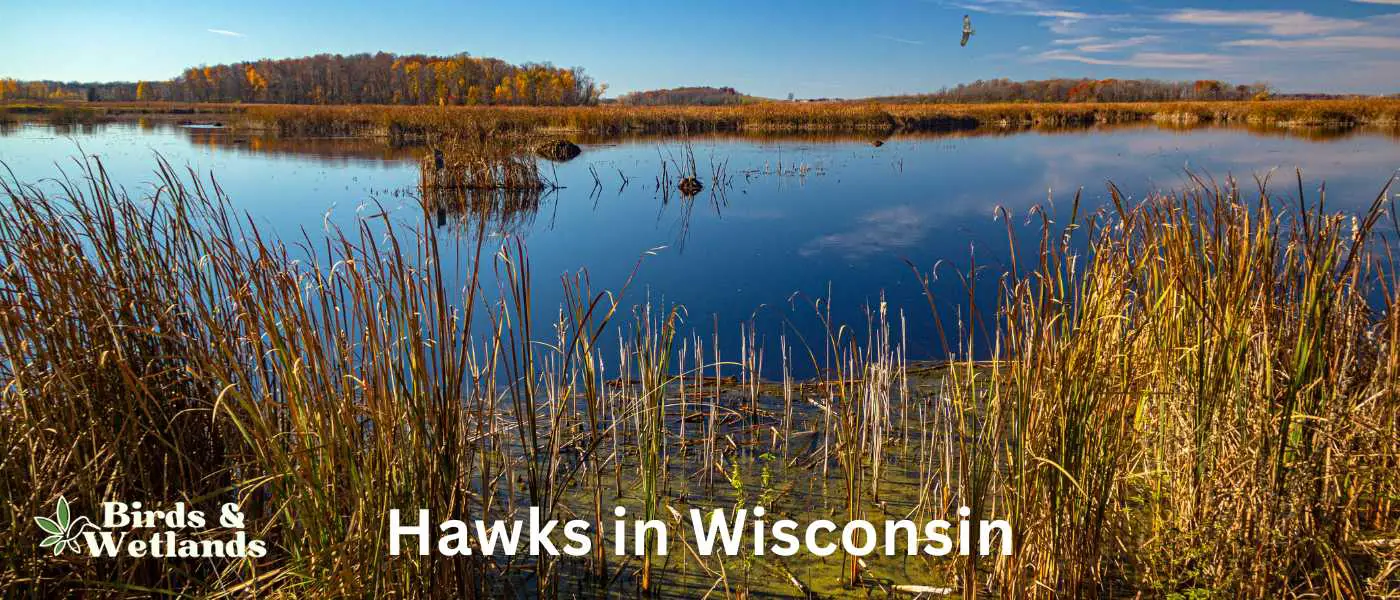Nestled amidst the great lakes and expansive forests, Wisconsin serves as a home for diverse wildlife, including a noteworthy variety of hawks. These powerful birds of prey, distinguished by their excellent hunting abilities, dramatic physical features, and elegant flight, play a crucial role in the Badger State’s vibrant ecosystem.
Whether flying high over the lake shores or perched in the northern woods, hawks in Wisconsin create a captivating spectacle for nature enthusiasts and casual observers alike. T
Types of Hawk in Wisconsin
Red-tailed Hawks The Red-tailed Hawk is a common and widespread hawk species in Wisconsin, found throughout the state in diverse habitats including open fields, woodlands, and urban areas. Look for them in locations such as the Horicon Marsh State Wildlife Area and the Kettle Moraine State Forest.
Cooper’s Hawks Cooper’s Hawks are frequently observed in Wisconsin’s woodlands, tall trees, suburban neighborhoods, and city parks. Keep an eye out for them in places like the Milwaukee County Parks and the Northern Highland-American Legion State Forest.
Sharp-shinned Hawks Sharp-Shinned Hawks can be seen in Horicon Marsh State Wildlife Area, known for its diverse habitats and bird species.
Red-shouldered Hawks Red-shouldered Hawks can be found in Wisconsin’s riparian habitats and wetland areas, especially along rivers and lakeshores. Observe them in locations such as the Upper Mississippi River National Wildlife and Fish Refuge and the Horicon National Wildlife Refuge.
Broad-winged Hawks Broad-winged Hawks breed in Wisconsin’s forests and can be seen during their migration periods, often forming kettles (large swirling flocks) during their journey. Look for them in locations such as the Southern Kettle Moraine State Forest and the Northern Unit of the Kettle Moraine State Forest.
Swainson’s Hawk: Swainson’s Hawks are rare in Wisconsin, but they have been occasionally spotted in open agricultural areas near Necedah National Wildlife Refuge.
Northern Harrier: Head to Buena Vista Grasslands in Portage County, a large grassland area, to spot Northern Harriers gliding low over the fields.
Ferruginous Hawk: Ferruginous Hawks are rare visitors to Wisconsin, but they have been occasionally sighted in the Crex Meadows Wildlife Area in Grantsburg.
Northern Goshawk: Look for Northern Goshawks in the Chequamegon-Nicolet National Forest, particularly in the forested areas of Vilas County.
Rough-Legged Hawk: During winter months, drive along the highways near Sauk Prairie and Buena Vista Grasslands to spot Rough-Legged Hawks perched on utility poles or hovering over fields.
Wisconsin Hawks Photo Guide
Red-tailed Hawk (Buteo jamaicensis)

The Red-tailed Hawk is a large bird of prey that is commonly found across North America. This species is part of the genus Buteo, which is often referred to as the “true hawks,” and includes more than two dozen species of raptors.
Red-tailed Hawks have a robust size, ranging from 18 to 26 inches in length and sporting a wingspan that can exceed 4 feet. They have a broad, rounded set of wings and a short, wide red tail. This species is most easily recognized by its rich, rust-colored tail, which gives it its common name. However, juvenile hawks might not yet have this distinctive feature.
Their feathers are generally dark brown on their dorsal side (back) with a lighter, often speckled, ventral side (front). The intensity and pattern of their plumage can vary significantly based on their age and geographic location, as there are about 14 recognized subspecies of Red-tailed Hawks.
As for their diet, Red-tailed Hawks are carnivores and have a broad diet that includes rodents, ground rabbits, reptiles, and other birds. They are skilled hunters that typically sit on high perches and use their keen eyesight to spot potential prey. Once they have identified a target, they swoop down to capture it with their powerful talons.
Red-tailed Hawks mate for life and build nests high off the ground, often in tall trees or on cliff edges. Their nests are made of sticks and can be quite large. They typically lay 1-3 eggs per year, which are incubated by both parents.
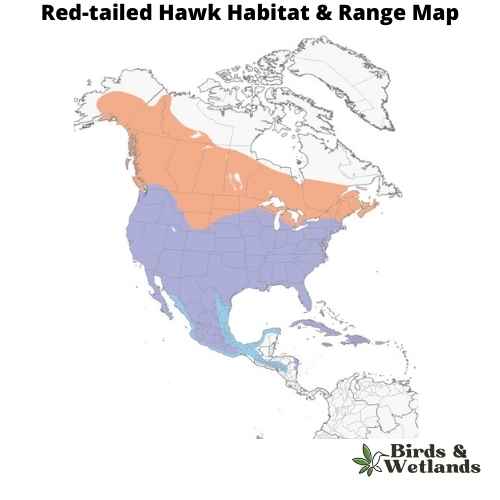
Red-tailed Hawk Sound
Cooper’s Hawk (Accipiter cooperii)

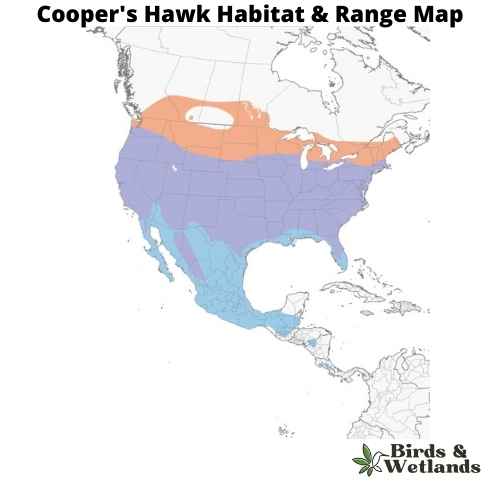
Listen:
The Cooper’s Hawk is a medium-sized bird of prey native to North America. Known for its agility and speed, it is part of the Accipitridae hawk species, which also includes other hawks, eagles, and kites.
Cooper’s Hawks are typically about 14 to 20 inches in length, with a wingspan ranging from 27 to 36 inches. They are known for their distinctive long, rounded tails and short, rounded wings. They have a steely blue gray top, with rusty bars on their underparts and thick, dark bands on their tails.
The Cooper’s Hawk is a skilled predator, primarily hunting birds and small mammals. They are adept at hunting in both dense forests and open areas, often catching prey mid-air in high-speed pursuits. They have also been known to visit the backyard bird feeder, not for the seed, but to prey on the smaller birds that gather there.
Cooper’s Hawks often build nests in dense tree canopies where they are well concealed. The female usually lays 3 to 5 eggs, and both parents share incubation duties. The young hawks fledge after about a month but will stay close to the nest, relying on their parents for food as they learn to hunt.
Sharp-shinned Hawk (Accipiter striatus)

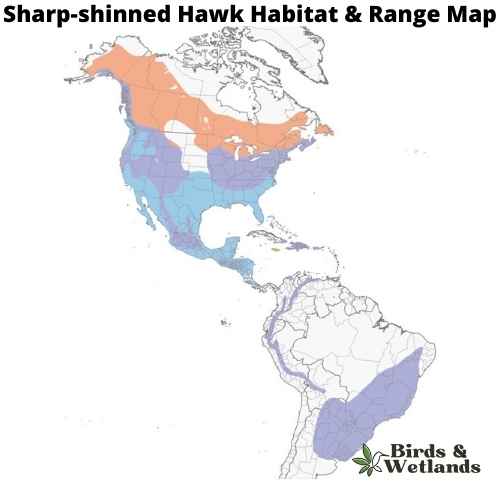
Listen:
The adult bird is brown on top and white underneath, with a dark brown band across its chest. It has short, rounded wings and a long tail that makes it look larger than it actually is. Adult sharp shinned hawks have black eyes, which are surrounded by white feathers. The female Sharp-shinned Hawk is browner than the male, who has darker brown markings on his back.
Sharp-shinned Hawks prefer open country for their habitat, including fields and meadows where they can hunt for mice and other small animals. They can be found throughout the United States but are most common in the east.
Sharp-shinned Hawks eat mostly small birds, such as sparrows and warblers, as well as small mammals such as mice and gophers. They catch prey by surprise using their incredible speed and agility, diving out of the sky at speeds up to 200 mph.
Sharp-shinned Hawks have an unusual hunting style for hawks—they prefer to catch their prey from perches above trees or telephone wires, rather than swooping down from above like most other hawks do and can often be seen hunting near bird feeders.
Red-shouldered Hawk (Buteo lineatus)

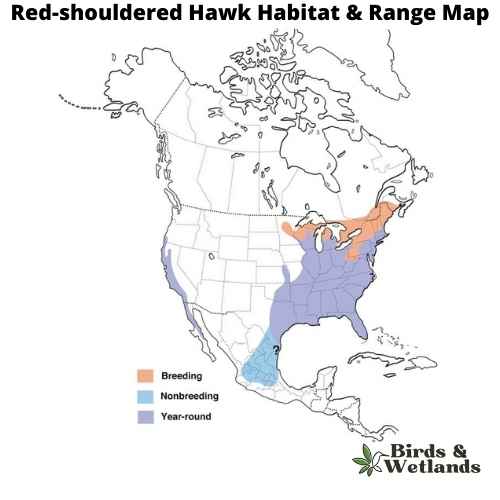
Listen:
The red-shouldered hawk are medium sized birds of prey, part of the buteo hawks family. It can be distinguished from other hawks by its reddish iris and pale legs.
The adult has rusty red upperparts, white underparts, a black chin and throat, and a reddish brown stripe over each eye, reddish brown heads and a strongly banded tail. The tail is reddish brown with two paler bands across it and they have white checkered wings. Juveniles are brown with dark barring and have pale fringes on the feathers of their wings.
Red-shouldered hawks nest in trees, though they also inhabit manmade structures including barns, bridges, and buildings. They prefer wooded areas with an open canopy but will use other places as well for nesting such as shrubs and hedges if needed.
The red-shouldered hawk’s diet – they eat small mammals such as ground squirrels, rabbits, voles, mice and rats. They also eat birds such as quail, pigeons and doves; reptiles including snakes; amphibians; fish; crustaceans; insects; and carrion (dead animals).
Broad-winged Hawk (Buteo platypterus)

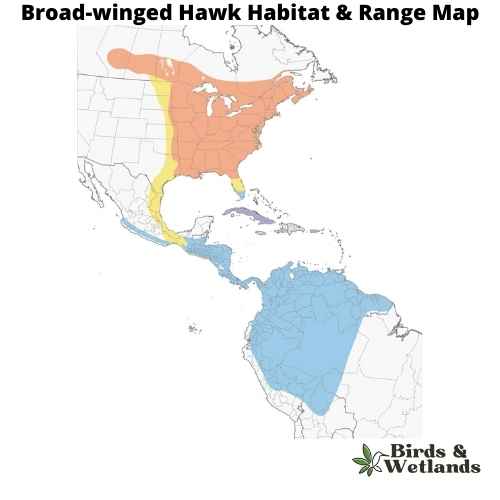
Broad-winged Hawk Sound
The Broad-winged Hawk holds a commanding presence as one of the largest hawks in the world, known for its broad wings. Its formidable size is a testament to its prowess as a bird of prey, effortlessly navigating the open skies in search of food.
Their distinctive appearance sets them apart. The adults exhibit a striking black and white pattern, complemented by a rusty breast and buff underparts and brown wings. In contrast, juveniles are adorned with a brown plumage, marked by pale edges on their feathers, adding to their distinctive youthful charm.
These hawks are most commonly found in open areas, such as farmlands or grasslands interspersed with scattered trees, which provide optimal conditions for when hawks hunt.
When it comes to their diet, Broad-winged Hawks feed on small rodents like mice, rats, squirrels, rabbits, and voles. Broad winged hawks breed during the spring and summer months then migrate to central and south America.
Where to Spot Hawks in Wisconsin
Hawk Ridge Bird Observatory: Situated in Duluth, Wisconsin, this observatory is globally recognized for its annual fall migration count of raptors, providing opportunities to see a variety of hawk species.
Devil’s Lake State Park: The high cliffs around the lake provide an ideal viewing platform for migrating hawks, especially during the fall migration season.
Horicon Marsh: The largest freshwater marsh in the United States, Horicon Marsh attracts a variety of raptors, including several species of hawks.
Wyalusing State Park: This park, where the Wisconsin and Mississippi Rivers converge, offers excellent viewing opportunities for migrating raptors, including hawks.
Wisconsin, with its varied landscape and prime location along migration routes, offers some fantastic hawk-watching spots. Exploring neighboring states and their unique bird-watching locations can add even more diversity to your hawk-watching experience.
Swainson’s Hawk (Buteo swainsoni)
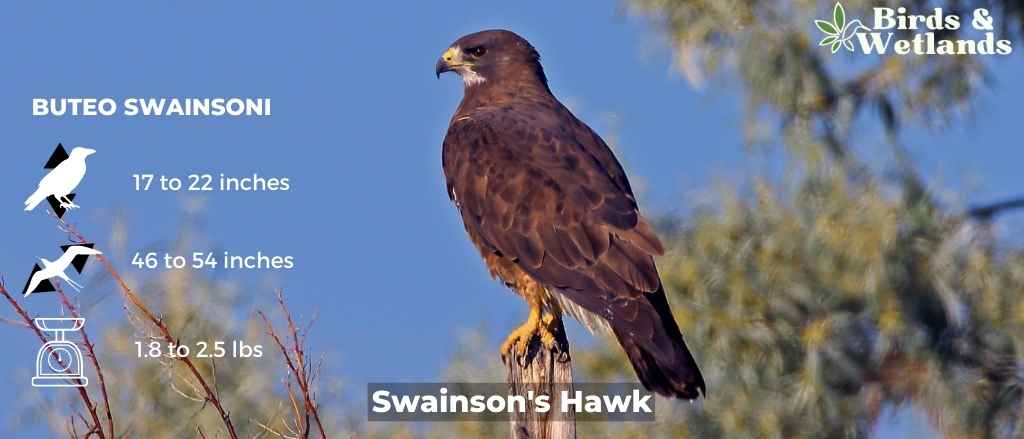
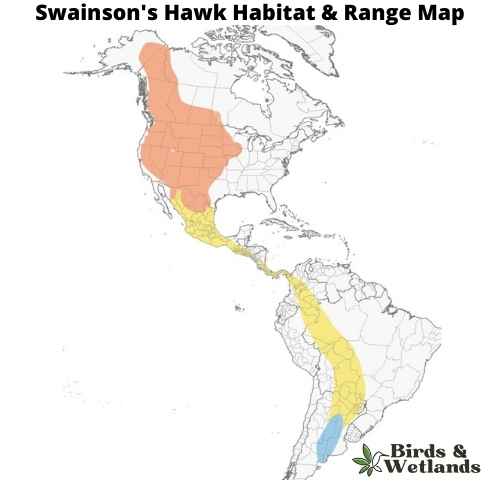
Listen: Swainson’s Hawk
Swainson’s Hawk is a medium-sized hawk that is found in North America and South America, Scientific Name: Buteo swainsoni.
The bird has a blue-gray plumage with a dark brown back, wings, and tail. It also has a white chest and belly. The beak and feet are black, but the eyes are yellow. They are often confused with Cooper’s Hawk because of similar coloring, but Swainson’s Hawks have wider tails and longer wings than their cousin species.
These birds eat small rodents such as gophers and mice. They also eat insects like grasshoppers and crickets during the summer months when they’re plentiful. They sometimes steal prey from other birds of prey such as Northern Harriers who hunt the same prey.
Swainson’s Hawks build nests on rocky cliffs near water sources where they can find food easily. They lay three to five eggs that hatch after about two months into fluffy brown baby hawks who leave the nest after about three weeks (or when they’re big enough).
Northern Harrier (Circus hudsonius)

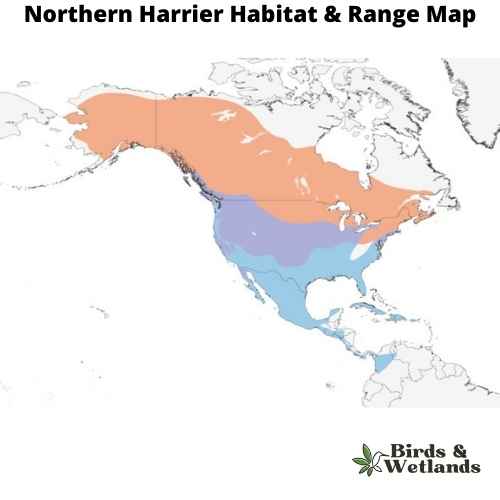
Listen:
The Northern Harrier is a medium-sized, slender hawk.
Adult birds are gray above, with pale bars on the wing feathers and white markings on the underwings and a white rump patch. The breast is barred with black and white, and the belly is streaked with brown.
They prefer open areas, such as grasslands and marshes, but can be found in almost any open habitat except dense woods.
Northern Harriers are opportunistic hunters that feed on small mammals such as mice, voles and rabbits as well as birds including quail, grouse and ducks. They hunt by flying low over open spaces such as fields or marshes.
Northern harrier nests on the ground in lowlands or hillsides near water bodies. It lays two to four eggs which hatch after 24 days of incubation by both parents. The chicks fledge after 30 days of hatching and remain dependent on their parents for another three weeks during which they learn how to fly.
Ferruginous Hawk (Buteo regalis)

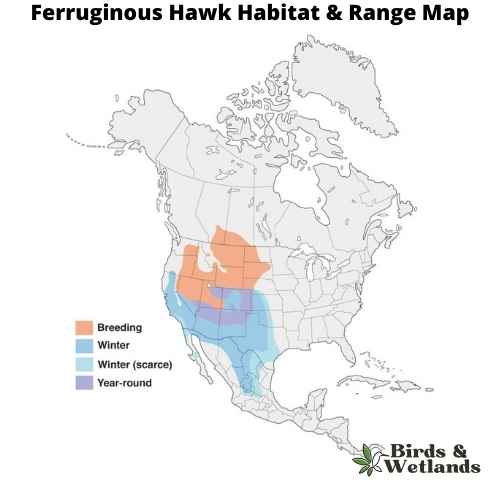
Ferruginous Hawk Sound
Scientific Name: Buteo regalis
Length: 20 to 27 in
Wingspan: 48 to 60 in
Weight: 32.0 to 80.0 oz
The Ferruginous Hawkis the largest hawk species native to North America. Known for its distinctive coloration and impressive size, this bird of prey predominantly inhabits the open landscapes of the western United States and parts of Canada.
Ferruginous Hawks are notable for their “ferruginous” or rust-colored back and shoulders, which contrasts sharply with the bird’s white underside. The hawk also has broad, rounded wings and a large, gape-mouthed beak. Ferruginous hawks exhibit dark morph and light morphs. Dark morphs have dark brown plumage, while light morphs display lighter, reddish-brown plumage. Morphs vary geographically.
Primarily feeding on small to medium sized mammals like rabbits and prairie dogs, the Ferruginous Hawk is an agile hunter, often seen soaring high above the ground or perched prominently while scanning for prey. It occasionally feeds on birds, reptiles, and insects as well.
Nesting for Ferruginous Hawks typically occurs on cliffs, hillsides, or large trees. The female lays between 2 to 5 eggs, and both parents share in the incubation and rearing of the chicks. The Ferruginous Hawk is a relatively solitary bird outside of the breeding season, and its call is a loud, high-pitched scream, often heard during courtship or near the nest.
Northern Goshawk (Accipiter gentilis)


Listen:
The Northern Goshawk is a medium-sized hawk that is found in North America, Europe and Asia. It has brown eyes, a large sharp beak, and dark brown plumage on its upperparts and head, with white underparts that are spotted with brown barring. Its tail feathers are grayish-black with a dark band near the tip.
Northern goshawks eat squirrels, rabbits, grouse, woodchucks and other small mammals like voles or mice (which they often eat whole). They will also take larger prey such as deer fawns or even adult deer if they have no other choice. They have broad wings with long feathers that allow them to glide through the air when they catch their prey. They also have an excellent sense of smell which helps them locate their food source.
The Northern Goshawk builds its nest in a tree cavity or on a ledge, usually on the edge of an open area so it can easily see prey below. The female lays 3 to 5 eggs over two days and incubates them for 28 to 30 days while the male brings food to her every few hours until they hatch. The young fledge after about 6 weeks and leave the nest when they are about 10 weeks old.
Rough-legged Hawk (Buteo lagopus)

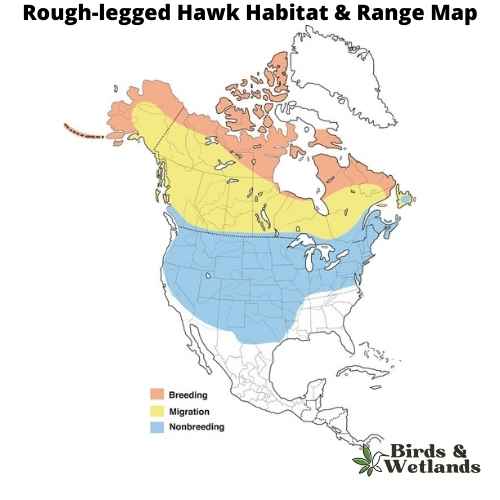
Rough-legged Hawk Sound
The Rough-legged Hawk is a large, raptor that is native to North America. It is also known as the American Rough-legged Hawk. Scientific Name: Buteo lagopus
The Rough-legged Hawk is a medium-sized hawk with a distinctive appearance, with dark brown feathers on its back and light brown feathers on its underside and broad thin wings. The hawk’s legs are also covered in dark feathers, which help to distinguish it from other species of hawk. The tail is barred with black and white. They have yellow eyes and dark feet.
Rough-legged Hawks hunt from above ground level, swooping down to catch its prey in its talons. When hunting for food, they prefer to eat small mammals such as squirrels and rabbits but will also eat birds if there aren’t any small mammals available. Although they eat a variety of small animals including birds, rodents, bats and reptiles, they rely heavily on fish for food during breeding season because it provides them with protein and calcium needed to produce eggs.
| Neighbouring State | Best Hawk Spotting Site |
|---|---|
| Illinois Hawks | Starved Rock State Park |
| Iowa Hawks | Effigy Mounds National Monument |
| Michigan Hawks | Whitefish Point Bird Observatory |
| Minnesota Hawks | Hawk Ridge Bird Observatory, Duluth |

